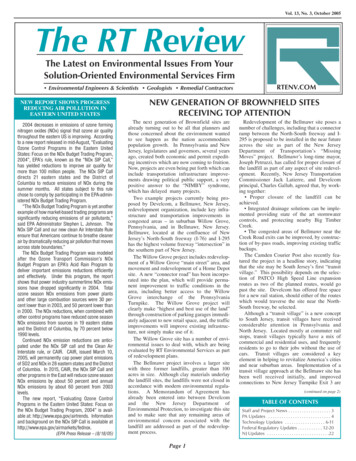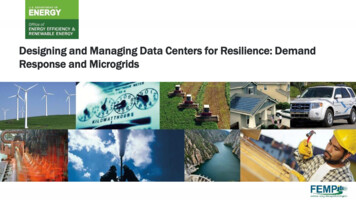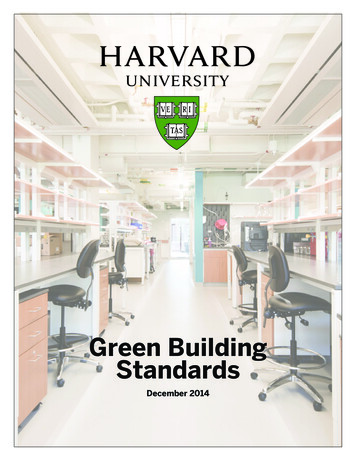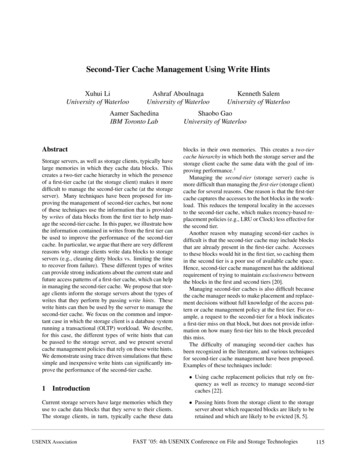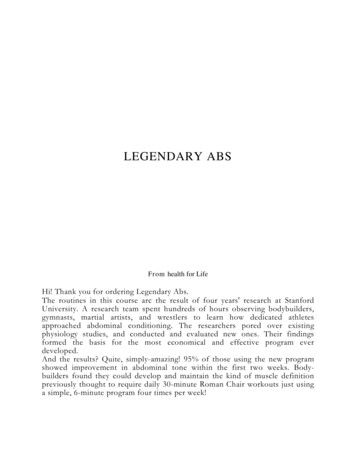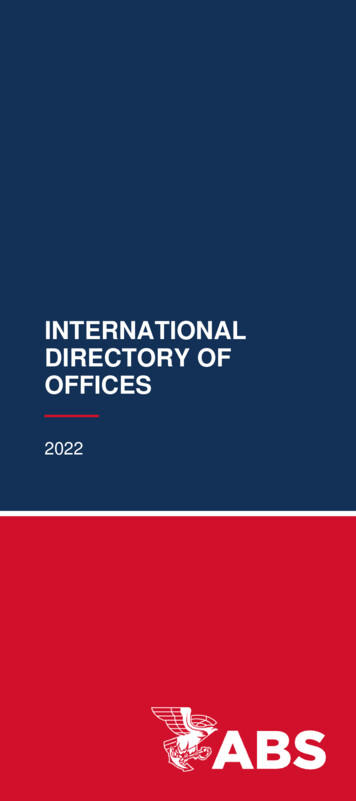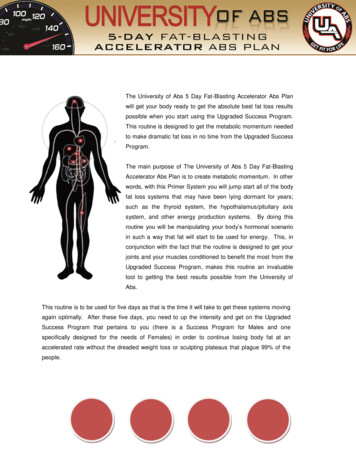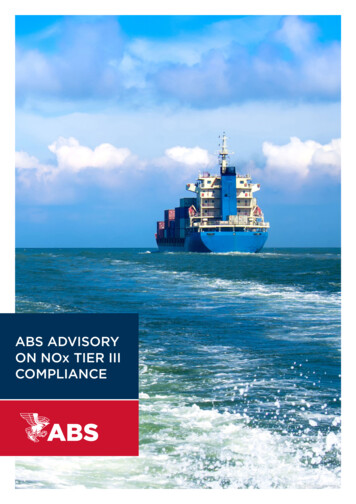
Transcription
ABS ADVISORYON NOx TIER IIICOMPLIANCE rodho/Shutterstock
——TABLE OF CONTENTSINTRODUCTION. . . . . . . . . . . . . . . . . . . . . . . . . . . . . . . . . . . . . . . . . . . . . . . . . . . . . . . . . . . . . . . . . . . . . . . . . . . . . . . . . . . . . 1SECTION 1 - EMISSION REQUIREMENTS . . . . . . . . . . . . . . . . . . . . . . . . . . . . . . . . . . . . . . . . . . . . . . . . . . . . . . . . . . . . . . 2IMO Regulation . . . . . . . . . . . . . . . . . . . . . . . . . . . . . . . . . . . . . . . . . . . . . . . . . . . . . . . . . . . . . . . . . . . . . . . . . . . . . . . . . . . . . . . . . . . . 2IMO Tier III Exception. . . . . . . . . . . . . . . . . . . . . . . . . . . . . . . . . . . . . . . . . . . . . . . . . . . . . . . . . . . . . . . . . . . . . . . . . . . . . . . . . . . . . . . 3Emission Control Areas. . . . . . . . . . . . . . . . . . . . . . . . . . . . . . . . . . . . . . . . . . . . . . . . . . . . . . . . . . . . . . . . . . . . . . . . . . . . . . . . . . . . . . 4Regional Emission Regulations. . . . . . . . . . . . . . . . . . . . . . . . . . . . . . . . . . . . . . . . . . . . . . . . . . . . . . . . . . . . . . . . . . . . . . . . . . . . . 4United States Regulation . . . . . . . . . . . . . . . . . . . . . . . . . . . . . . . . . . . . . . . . . . . . . . . . . . . . . . . . . . . . . . . . . . . . . . . . . . . . . . . . . . . . 4California Air Resource Board Regulations. . . . . . . . . . . . . . . . . . . . . . . . . . . . . . . . . . . . . . . . . . . . . . . . . . . . . . . . . . . . . . . . . . 5China. . . . . . . . . . . . . . . . . . . . . . . . . . . . . . . . . . . . . . . . . . . . . . . . . . . . . . . . . . . . . . . . . . . . . . . . . . . . . . . . . . . . . . . . . . . . . . . . . . . . . . . . 6Norwegian Maritime Authority Regulations. . . . . . . . . . . . . . . . . . . . . . . . . . . . . . . . . . . . . . . . . . . . . . . . . . . . . . . . . . . . . . . . 6Norwegian NOx Fund. . . . . . . . . . . . . . . . . . . . . . . . . . . . . . . . . . . . . . . . . . . . . . . . . . . . . . . . . . . . . . . . . . . . . . . . . . . . . . . . . . . . . . . 7IACS . . . . . . . . . . . . . . . . . . . . . . . . . . . . . . . . . . . . . . . . . . . . . . . . . . . . . . . . . . . . . . . . . . . . . . . . . . . . . . . . . . . . . . . . . . . . . . . . . . . . . . . 7ABS Rules. . . . . . . . . . . . . . . . . . . . . . . . . . . . . . . . . . . . . . . . . . . . . . . . . . . . . . . . . . . . . . . . . . . . . . . . . . . . . . . . . . . . . . . . . . . . . . . . . . 7SECTION 2 - APPROVAL AND CERTIFICATION PROCESS. . . . . . . . . . . . . . . . . . . . . . . . . . . . . . . . . . . . . . . . . . . . . . . 8General . . . . . . . . . . . . . . . . . . . . . . . . . . . . . . . . . . . . . . . . . . . . . . . . . . . . . . . . . . . . . . . . . . . . . . . . . . . . . . . . . . . . . . . . . . . . . . . . . . . . 8Statutory Approval. . . . . . . . . . . . . . . . . . . . . . . . . . . . . . . . . . . . . . . . . . . . . . . . . . . . . . . . . . . . . . . . . . . . . . . . . . . . . . . . . . . . . . . . . 8General:. . . . . . . . . . . . . . . . . . . . . . . . . . . . . . . . . . . . . . . . . . . . . . . . . . . . . . . . . . . . . . . . . . . . . . . . . . . . . . . . . . . . . . . . . . . . . . . . . . . . . . 8Engine Pre-Certification. . . . . . . . . . . . . . . . . . . . . . . . . . . . . . . . . . . . . . . . . . . . . . . . . . . . . . . . . . . . . . . . . . . . . . . . . . . . . . . . . . . . . 8Engine with SCR for NOx Tier III Compliance:. . . . . . . . . . . . . . . . . . . . . . . . . . . . . . . . . . . . . . . . . . . . . . . . . . . . . . . . . . . . . . 10Retrofit of SCR to Onboard Engine for NOx Tier III Compliance:. . . . . . . . . . . . . . . . . . . . . . . . . . . . . . . . . . . . . . . . . . . . 11Class Approval . . . . . . . . . . . . . . . . . . . . . . . . . . . . . . . . . . . . . . . . . . . . . . . . . . . . . . . . . . . . . . . . . . . . . . . . . . . . . . . . . . . . . . . . . . . . 12SECTION 3 - NOX REDUCTION TECHNOLOGIES. . . . . . . . . . . . . . . . . . . . . . . . . . . . . . . . . . . . . . . . . . . . . . . . . . . . . . . 13General . . . . . . . . . . . . . . . . . . . . . . . . . . . . . . . . . . . . . . . . . . . . . . . . . . . . . . . . . . . . . . . . . . . . . . . . . . . . . . . . . . . . . . . . . . . . . . . . . . . 13Selective Catalytic Reduction (SCR) . . . . . . . . . . . . . . . . . . . . . . . . . . . . . . . . . . . . . . . . . . . . . . . . . . . . . . . . . . . . . . . . . . . . . . . . 13Principle of Operation. . . . . . . . . . . . . . . . . . . . . . . . . . . . . . . . . . . . . . . . . . . . . . . . . . . . . . . . . . . . . . . . . . . . . . . . . . . . . . . . . . . . . . . 13System Configuration . . . . . . . . . . . . . . . . . . . . . . . . . . . . . . . . . . . . . . . . . . . . . . . . . . . . . . . . . . . . . . . . . . . . . . . . . . . . . . . . . . . . . . . 14Consideration for SCR Application . . . . . . . . . . . . . . . . . . . . . . . . . . . . . . . . . . . . . . . . . . . . . . . . . . . . . . . . . . . . . . . . . . . . . . . . . . 14Retrofitting of SCR for Tier III Compliance. . . . . . . . . . . . . . . . . . . . . . . . . . . . . . . . . . . . . . . . . . . . . . . . . . . . . . . . . . . . . . . . . 16Exhaust Gas Recirculation. . . . . . . . . . . . . . . . . . . . . . . . . . . . . . . . . . . . . . . . . . . . . . . . . . . . . . . . . . . . . . . . . . . . . . . . . . . . . . . . . 16Principle of Operation. . . . . . . . . . . . . . . . . . . . . . . . . . . . . . . . . . . . . . . . . . . . . . . . . . . . . . . . . . . . . . . . . . . . . . . . . . . . . . . . . . . . . . . 16System Configuration . . . . . . . . . . . . . . . . . . . . . . . . . . . . . . . . . . . . . . . . . . . . . . . . . . . . . . . . . . . . . . . . . . . . . . . . . . . . . . . . . . . . . . . 17Consideration for EGR Application. . . . . . . . . . . . . . . . . . . . . . . . . . . . . . . . . . . . . . . . . . . . . . . . . . . . . . . . . . . . . . . . . . . . . . . . . . 18
Dual Fuel and Gas Fueled (Otto) Engines. . . . . . . . . . . . . . . . . . . . . . . . . . . . . . . . . . . . . . . . . . . . . . . . . . . . . . . . . . . . . . . . . . . 19Principle of Operation. . . . . . . . . . . . . . . . . . . . . . . . . . . . . . . . . . . . . . . . . . . . . . . . . . . . . . . . . . . . . . . . . . . . . . . . . . . . . . . . . . . . . . . 19Consideration for Dual Fuel and Gas Fueled Engine . . . . . . . . . . . . . . . . . . . . . . . . . . . . . . . . . . . . . . . . . . . . . . . . . . . . . . . . 19Other Potential Options. . . . . . . . . . . . . . . . . . . . . . . . . . . . . . . . . . . . . . . . . . . . . . . . . . . . . . . . . . . . . . . . . . . . . . . . . . . . . . . . . . . 20SECTION 4 - SHIPBOARD SUITABILITY AND COMPATIBILITY . . . . . . . . . . . . . . . . . . . . . . . . . . . . . . . . . . . . . . . . . . 22Compatibility with Sulfur Compliance Options. . . . . . . . . . . . . . . . . . . . . . . . . . . . . . . . . . . . . . . . . . . . . . . . . . . . . . . . . . . . 22Main Engine NOx Measurement and Amendment of NOx Technical File Due to SOx Scrubber Retrofit. . . . . 22EFFECT OF SCR ON EXHAUST GAS BOILER (EGB). . . . . . . . . . . . . . . . . . . . . . . . . . . . . . . . . . . . . . . . . . . . . . . . . . . . . . . . . . . 23Financial ASPECT . . . . . . . . . . . . . . . . . . . . . . . . . . . . . . . . . . . . . . . . . . . . . . . . . . . . . . . . . . . . . . . . . . . . . . . . . . . . . . . . . . . . . . . . . 23SECTION 5 - OPERATION CONSIDERATIONS. . . . . . . . . . . . . . . . . . . . . . . . . . . . . . . . . . . . . . . . . . . . . . . . . . . . . . . . . 24Auxiliary Control Device (ACD) and EPA Policy. . . . . . . . . . . . . . . . . . . . . . . . . . . . . . . . . . . . . . . . . . . . . . . . . . . . . . . . . . . . 24Annual Spot Check Measurements for SCR Systems. . . . . . . . . . . . . . . . . . . . . . . . . . . . . . . . . . . . . . . . . . . . . . . . . . . . . . . . 25Tier II/III Changeover/on-off Recording Requirements . . . . . . . . . . . . . . . . . . . . . . . . . . . . . . . . . . . . . . . . . . . . . . . . . . . . 25ABS SUPPORT . . . . . . . . . . . . . . . . . . . . . . . . . . . . . . . . . . . . . . . . . . . . . . . . . . . . . . . . . . . . . . . . . . . . . . . . . . . . . . . . . . . . 26REFERENCES. . . . . . . . . . . . . . . . . . . . . . . . . . . . . . . . . . . . . . . . . . . . . . . . . . . . . . . . . . . . . . . . . . . . . . . . . . . . . . . . . . . . . 27APPENDIX I: FREQUENTLY ASKED QUESTIONS . . . . . . . . . . . . . . . . . . . . . . . . . . . . . . . . . . . . . . . . . . . . . . . . . . . . . . 28LIST OF ACRONYMS. . . . . . . . . . . . . . . . . . . . . . . . . . . . . . . . . . . . . . . . . . . . . . . . . . . . . . . . . . . . . . . . . . . . . . . . . . . . . . . 32
——INTRODUCTIONNitrogen Oxide (NOx) is one of the gaseous pollutants from ships regulated by the International Convention for thePrevention of Pollution from Ships (MARPOL Annex VI(1)), published by the International Maritime Organization (IMO).Under Regulation 13 of MARPOL Annex VI, three tiers of Nitrogen Oxide (NOx) emission limits are set for diesel engineswith a power output higher than 130 kW, i.e., IMO Tier I, Tier II and Tier III. Each Tier limits the NOx emission to a specificvalue based on the rated engine speed.Diesel engines for installation on a ship constructed on or after January 1, 2016 are subject to IMO Tier III requirementswhen the ship is operating in a NOx Tier III emission control area (NOx ECA) designated under Regulation 13 of MARPOLAnnex VI.The North American area and the United States Caribbean Sea area are currently designated as a NOx ECA. The Baltic Seaarea and the North Sea are designated as a NOx ECA under MEPC. 286 (71)(2), to which the IMO NOx Tier III requirementswill be applicable from January 1, 2021.The air emission requirements are driving the development of primary engine technologies and secondary exhaustemissions abatement systems to reduce exhaust emissions from ships. As a result, a number of techniques and designfeatures are utilized by internal combustion engine manufacturers to reduce NOx emissions. The predominanttechnologies used to achieve compliance with the IMO Tier III limit include reduction of NOx emission at the source andthe treatment of the exhaust gas after combustion.This ABS Advisory is developed to provide some of the best practices for IMO Tier III compliance for new builds as well asexisting ships (retrofitted), including an overview of available technologies, consideration for the selection of complianceoptions, process for statutory and class approval, practice for installation and integration, and challenges during operation.Some regional, national and local air emission requirements legislations impose limitations on the NOx emissions fromships in addition to the MARPOL regulations. This Advisory also provides information on the respective NOx emissionlimits, the geographic boundaries, and the compliance criteria set by various authorities.1 ADVISORY ON NOx TIER III COMPLIANCE ABS
——SECTION 1 - EMISSION REQUIREMENTSIMO REGULATIONThe International Convention for the Prevention of Pollution from Ships, known universally as MARPOL, was adoptedby IMO in 1973. In 1997, an IMO international conference of parties to MARPOL adopted the 1997 Protocol to the MARPOLConvention which added a new Annex VI - Regulations for the Prevention of Air Pollution from Ships, based on theregulatory text developed by the IMO Marine Environment Protection Committee (MEPC). This Annex entered into forceon May 19, 2005. The conference also adopted the Technical Code onControl of Emission of Nitrogen Oxides from Marine Diesel Engines(NOx Technical Code – NTC)(3).The new Annex VI introduced the first international shippingair pollution controls for Ozone Depleting Substances, NitrogenOxides, Sulfur Oxides, Volatile Organic Compounds and shipboardincineration. The Annex sets the general regulatory frameworkand limits for prevention of air pollution from ships with detailedrequirements for survey, certification and means of control. TheNTC provides the mandatory procedures for the testing, surveyand certification of marine diesel engines to Regulation 13 thatenables engine designers/ manufacturers, shipowner and operatorsto demonstrate and verify that all applicable marine dieselengines comply with the relevant NOx emission value limits. TheNTC is in part based on the ISO 8178(4) (9) series of standards forexhaust emissions measurement including test fuels, test cycles,measurement, reporting, and engine family or engine groupdefinitions.To reduce the harmful effects of NOx emissions on human healthand the environment, Regulation 13 of the MARPOL Annex detailedthe limits for NOx emissions from diesel engines. Regulation 13mandates that all marine diesel engines over 130kW installed ona vessels subject to MARPOL Annex VI are to comply with the IMOapplicable emission limit except engines solely used for emergencyapplication such as engines for emergency generators, emergencyfire pumps and engines installed in lifeboats. However, diesel engines used to drive external fire monitor pumps onfirefighting vessels are not eligible for exemption unless advised otherwise by the Administration. Diesel engines installedin ships not engaged in international voyages may also be exempted provided such engines are subject to an alternativeNOx control measure established by the Administration in whose waters the vessel is intended operate.Marine diesel engines are defined by IMO as any reciprocating internal combustion engine operating on liquid or gaseousor dual fuels, operating on Diesel combustion, or Otto combustion cycle, including gas fueled engines where gas/airmixture can be ignited by the combustion of a certain amount of fuel (pilot injection) or by extraneous ignition (sparkplug). The NOx emission limits are therefore also applicable to pure gas spark ignited engines. NOx formation is linkedto peak combustion temperatures, and with inherently lower temperatures the natural gas burning engines that usethe Otto combustion process in gas mode can meet the Tier III NOx limits of Regulation 13 without exhaust emissionsaftertreatment equipment. For more information on gas and dual fuel engines, and the differences between Diesel andOtto combustion cycles see the prime mover section of the ABS Advisory on Gas and Other Low Flashpoint Fuels.ABS ADVISORY ON NOx TIER III COMPLIANCE 2
The IMO engine NOx limits are based on enginerated speed (see Figure 1), with the lowest limitsapplicable to medium and high-speed engines.The application date of the Regulation 13 NOxemission limits is tied to the ship constructiondate.IMO ANNEX VI NOx LIMITS1816Tier I - 1 Jan 2000n 130rpm 17g/kWh130rpm n 2000rpm - 45*n 0.2g/kWhn 2000rpm 9.8g/kWhNOx (g/kWh)141210The 58th IMO MEPC session in October 2008adopted further significant changes to Annex VIand the NTC under Resolutions MEPC.176(58)(10)and MEPC.177(58)(11) respectively. These changesentered into force on July 1, 2010.Tier II - 1 Jan 2011n 130rpm 14.4g/kWh130rpm n 2000rpm - 44*n 0.23g/kWhn 2000rpm 7.7 g/kWh86Tier III - 1 Jan 2016n 130rpm 3.4g/kWh130rpm n 2000rpm - 9*n 0.2g/kWhn 2000rpm 2.0g/kWh42005001000150020002500Speed (rpm)RPMNOx calculated as total weighted emissionof NO2 (g/kWh) 130130 n 2000 2000RelativeReductionfrom Tier ITier I17.045*n9.80%Tier II14.444*n(-0.23)7.715.5% - 21.8%Tier III3.49*n(-0.2)2.080%(-0.2)Figure 1: IMO MARPOL ANNEX VI Regulation 13 NOx LimitsThe Tier I NOx limit was retrospectivelyapplicable to engines fitted to ships with keelslaid on or after January 1, 2000 once Annex VIentered into force on May 19, 2005. The 2008amendments progressively reduced the NOxlimits, with the Tier II limit entering into force onJanuary 1, 2011. The amendments also introducedthe Tier III limit, which is only applicable in ECAs,and represents a NOx reduction of approximately80% from the Tier I limit. Where an SCR unit isinstalled to comply with the IMO Tier III NOxlimits it is to be approved in accordance withthe additional requirements of the IMO SCRguidelines, currently as amended byMEPC.291(71)(12) and MEPC.313(74).IMO TIER III EXCEPTIONRegulation 13.5.2.3 of MARPOL Annex VI, as adopted by Resolution MEPC.251(66)(13), allows a five-year delay in the applicationof the Tier III limits until January 1, 2021 for ships (generally applicable to large yachts) of less than 500 gross tonnage, witha length of 24m or over, that are specifically designed and used solely for recreational purposes.The proposal to pursue further delay of application of the Tier III NOx requirements for such vessels beyond January 1,2021was considered at the MEPC 74th session meeting. The committee concluded that there was insufficient support for theproposal, as detailed in paragraphs 5.68 through 5.72 of the MEPC 74/18 Report. Therefore, marine engines installed on suchyachts constructed on or after January 1, 2021 are to comply with the Tier III emission requirement.The IMO NOx Tier application dates are given in Table 1, with the Tier III exemption provisions for engines of less than750kW and small vessels designed and used for recreational purposes.Emission LimitApplication ofRequirementsShip Constructed( January 1)2000 x 2011Tier I2011 x 2016Tier IIEngine 130 kW (#)Tier IIIOperation AreasOperating outside andinside of ECA 2016Operating outside of ECA 20163 exceptions (*)North American ECA and theU.S. Caribbean Sea ECA 20213 exceptions (*)Baltic Sea and North Sea ECAs#except engines solely for emergencies, or to power any devices/equipment for emergencies, or installed on lifeboatsolely for emergencies*L 24m if used for recreational purposes; ortotal propulsion 750kW if unable to achieve due to design limitations; orpurely recreational ships constructed prior to January 1, 2021 less than 500 GT and L 24m.Table 1: Application of IMO NOx Limits3 ADVISORY ON NOx TIER III COMPLIANCE ABS
EMISSION CONTROL AREASCurrently the only NOx ECAs in force are the North American (see Figure 2) and United States Caribbean Sea ECAs (seeFigure 3), which entered into force on January 1, 2016. The existing Baltic and North Sea SOx ECAs (see Figure 4) weredesignated as NOx ECAs at the 71st MEPC session meeting by Resolution MEPC.286(71), with the application of the Tier IIIrequirements in these ECAs to start from January 1, 2021.British VirginIslandsPuerto RicoUS Virgin IslandsFigure 3: United States Caribbean Sea ECABalticFigure 2: North American ECANorthSeaFigure 4: Baltic and North Sea ECAREGIONAL EMISSION REGULATIONSSome regional, national and local authorities have taken a different approach or introduced additional measures to limitNOx. The following paragraphs provide information on the different approaches taken by those authorities, including theU.S. Environmental Protection Agency (EPA), California Air Resource Board (CARB), and Norwegian Maritime Authority.The briefing of the regional emission regulation are based on ABS understanding. Users of this document should contactthe respective authority for interpretation and implementation of their regulation.UNITED STATES REGULATIONThe U.S. Environmental Protection Agency (EPA) and U.S. Coast Guard are authorized to administer MARPOL Annex VI bythe Act to Prevent Pollution from Ships. U.S. EPA regulations implementing Annex VI are codified at 40 CFR Part 1043. TheNOx emission limits in Regulation 13 of MARPOL Annex VI are applicable to U.S. flagged ships trading in internationalwaters and foreign flag ships while operating in the U.S. ECA areas. US flagged vessels are also subject to enginerequirements under the Clean Air Act. The U.S. EPA categorizes marine engines as follows under Clean Air Act regulationsin 40 CFR part 1042: Category 1: Displacement 7.0 liter/cylinder Category 2: Displacement from 7.0 and above but 30 liter/cylinder Category 3: Displacement 30 liter/cylinderABS ADVISORY ON NOx TIER III COMPLIANCE 4
Engines intended to be installed onboard U.S. flagged vessels are to comply with the emission requirements laid down in40 CFR Part 1042(14) and 40 CFR Part 1043(15). Category 1 and 2 engines are to comply with the emission Tiers in accordancewith Tables 1, 2, 3, 4 of 40 CFR Part 1042.101. Category 3 engines are to comply with Table 1 of 40 CFR Part 1042.104, which isequivalent to the IMO NOx emission levels, except that the CFR also sets a HC limit of 2.0g/kWh and a CO limit of 5.0g/kWh under Tier 2/II and Tier 3/III.Such engines needing an Engine International Air Pollution Prevention (EIAPP) Certificate must be covered by anEIAPP Certificate that is issued by the U.S. EPA. Engines on U.S. flagged vessels that do not operate in waters subject tothe jurisdiction of another country may comply with the EPA’s domestic emission standards in lieu of compliance withAnnex VI.Note: The EPA has four NOx emission Tiers written in Arabic numerals (e.g. Tier 1, 2, 3 & 4) compared to IMO MARPOL, whichhas three NOx emission Tiers written in Roman numerals (e.g. Tier I, II & III).On October 17, 2018 the United States Coast Guard (USCG) released a Work Instruction (WI) to clarify how it will enforceRegulation 13.5.1.2 of Annex VI due to the unavailability of Tier III engines of the size required to comply with thisregulation. The USCG will defer enforcement of this regulation on qualified vessels and engines;. In lieu of meetingMARPOL Annex VI Tier III performance standards, engines with rating of 130 kW to 600 kW installed on vessels with keellaying date on or after January 1, 2016 may instead be accepted by the US Government provided they meet the Clean Air ActTier 3 requirements under 40 CFR part 1042.Such certified engines are available and will be accepted in the short-term if available engines of the required sizecertified to meet MARPOL Annex VI Tier III are demonstrated to be unsuitable . This WI is applicable to U.S.-flagged andforeign-flagged vessels.For further information on EPA emission standards for nonroad engines and vehicles please refer -vehiclesEPA Policy and Guidance DocumentsEPA also provides guidance on particular topics for compliance issues for the North American and U.S. Caribbean Sea ECA .Please refer to the following web pages for the relevant EPA policy and guidance documents. https://iaspub.epa.gov/otaqpub/ tandards-marine -marine-compression-ignition-ci-enginesCALIFORNIA AIR RESOURCE BOARD REGULATIONSIn addition to U.S. EPA requirements, the California Air Resource Board (CARB) implements California Code of Regulation(CCR) to control NOx and Particulate Matter emission from the operation of auxiliary engines on ocean going vessels whiledocked at berth at a California port.The current applicable California Code of Regulation is title 17 Section 93118.3, “Airborne Toxic Control Measure for AuxiliaryDiesel Engines Operated on Ocean-Going Vessels At-berth in a California Port”(16). This CCR is applicable to U.S. or foreignflagged container vessels, passenger vessels, and refrigerated cargo vessels when they visit California ports, including thePort of Los Angeles, Long Beach, Oakland, San Diego, Hueneme and San Francisco.Exemption of the CCR requirements apply to the following: Ocean-going vessel voyages that consist of continuous and expeditious navigation through any of the RegulatedCalifornia Waters for the purpose of traversing such bodies of water without entering California internal orestuarine waters or calling at a port, roadstead, or terminal facility Steamships Auxiliary engines operating primarily on liquefied natural gas (LNG) or compressed natural gas (CNG)The emission/power reduction percentages phase in from 10% in 2010 to 80% in 2020. The CCR accepts the following twopathways for the reduction of emissions: Reduced on-board power generation Equivalent emission reduction5 ADVISORY ON NOx TIER III COMPLIANCE ABS
The first pathway option limits the hours of operation of auxiliary generator engines and the power generated on-boardwhile docked at the berth.The CCR set operation time limits for the specified percentage of visits by the fleet during a defined calendar year. Thetime limit is either 3 hours or 5 hours, depending on power transfer process to change from vessel-based power to shorebased power. For example, beginning January 1, 2020, the CCR require that at least 80% of a fleet’s total number of visits tothe port (e.g., for container vessels, if total time of visits by a fleet is 30, then 24 out of the 30 visits) shall operate auxiliaryengines no more than 3 hours per visit to a berth if the visiting vessel uses a synchronous power transfer process. Ifsynchronous power transfer process is not used, the time limit for each visit is 5 hours. The 3- or 5-hour limit applies to thecombined operating time for all auxiliary diesel engines used in a vessel visit, rather than on a per-engine basis.For reduction of on-board power generation, taking the 2020 requirements as example, the fleet’s onboard auxiliary-dieselengine power generation while docked at berth shall be reduced by at least 80% from the fleet baseline power generation.Baseline fleet power generation is the product of berthing time and power requirement of a fleet during docked at berth.The other option is through the application of equivalent emission reduction to reduce the emissions of the fleet, i.e., usingone or more control techniques including electric power from the utility grid, electrical power from sources that are notpart of an utility’s electrical grid (distributed generation), or alternative control technologies e.g. SCR, so that the emissionon a fleet basis is reduced to the required percentage of baseline fleet emissions. For example, for the quarter beginningon January 1, 2020, and each subsequent quarter thereafter, the NOx and Particulate Matter emissions from the fleet’sauxiliary engines when the
1 ADVISORY ON NOx TIER III COMPLIANCE ABS INTRODUCTION Nitrogen Oxide (NOx) is one of the gaseous pollutants from ships regulated by the International Convention for the Prevention of Pollution from Ships (MARPOL Annex VI(1)), published by the International Maritime Organization (IMO) . Under Regulation 13 of MARPOL Annex VI, three tiers of Nitrogen Oxide (NOx) emission limits are set for .
